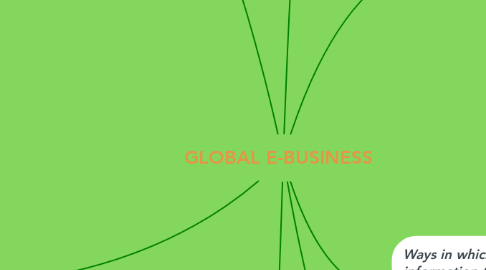
1. Types of IS: Systems from a constituency perspective
1.1. Transaction processing systems
1.1.1. Supporting operational level employees
1.1.1.1. Serve operational levels
1.1.1.2. Serve predefined, structured goals and decision making
1.1.1.3. Perform and record daily routine transactions
1.2. Management information systems and decision-support systems
1.2.1. Supporting middle managers
1.2.1.1. Provide reports on firm’s current performance
1.2.1.2. Typically have little analytic capability
1.2.1.3. Provide answers to routine questions
1.3. Executive support systems
1.3.1. Supporting executives(senior managers)
1.3.1.1. Address non-routine decisions
1.3.1.2. Incorporate data about external events
1.3.1.3. Incorporate summarized information from internal MIS and DSS
2. Relationship of systems to one another
2.1. TPS
2.1.1. Major source of data for other systems
2.2. ESS
2.2.1. Recipient of data from lower-level systems
2.3. Data may be exchanged between systems
3. Types of IS: Systems that span enterprise
3.1. Enterprise applications: Span functional areas
3.1.1. Enterprise systems
3.1.1.1. Collects data
3.1.1.2. Resolves problem
3.1.1.3. Enable coordination of daily activities
3.1.1.4. Efficient response to customer orders
3.1.2. Supply chain management systems
3.1.2.1. Manage firm’s relationships with suppliers
3.1.2.2. Share information
3.1.3. Customer relationship management systems
3.1.3.1. Provide information to coordinate all of the business processes
3.1.3.2. Integrate firm’s customer-related processes
3.1.3.3. Consolidate customer information
3.1.4. Knowledge management systems
3.1.4.1. Collect internal knowledge and link to external knowledge
3.1.4.2. Support processes
3.1.4.3. Includes enterprise-wide systems
3.2. Intranets
3.2.1. Internal networks
3.2.2. Used for internal distribution of information
3.2.3. Connects to company’s transaction systems
3.3. Extranets
3.3.1. Authorized users outside the company
3.3.2. Expedite flow of information
3.3.3. Another firms can collaborate
3.4. E-business (Electronic business)
3.4.1. Use of digital technology and Internet to execute major business processes
3.4.2. Includes e-commerce
3.4.2.1. Buying and selling of goods over Internet
3.5. E-government
3.5.1. Digitally enable government and public sector agencies’ relationships with citizens
4. Business processes
4.1. Workflows of material, information, knowledge
4.2. Sets of activities, steps
5. Ways in which IS enhances information technology
5.1. Increasing efficiency of existing processes
5.2. Enabling entirely new processes
6. Types of IS: Systems from a functional perspective
6.1. Sales and marketing systems
6.1.1. Sales management
6.1.2. Customer identification
6.1.3. Advertising and promotion
6.1.4. Market research
6.1.5. Pricing and new products
6.2. Manufacturing and production systems
6.2.1. Managing production facilities
6.2.2. Production goals
6.2.3. Production materials and scheduling
6.3. Finance and accounting systems
6.3.1. Managing financial assets (cash, stocks, etc.)
6.3.2. Capitalization of firm
6.3.3. Managing firm’s financial records
6.4. Human resources systems
6.4.1. Identifying potential employees
6.4.2. Maintaining employee records
6.4.3. Creating programs to develop employee talent and skills
7. The IS function in business
7.1. Information systems department:
7.1.1. Responsible for information technology services
7.1.2. Headed by chief information officer
7.1.3. Includes programmers, systems analysts, project leaders
7.2. End-users
7.2.1. Representatives of other departments
7.2.2. Here applications are developed
7.2.3. Small firm may not have formal information systems group
7.2.4. Larger companies have separate department
7.2.4.1. Decentralized
7.2.4.2. Separate department under central control
7.2.4.3. Each division has separate group

